» posted on Monday, August 22nd, 2022 by Linda Lou Burton
Then Let’s Do That
Originally published August 15, 2020 by Linda Lou Burton posting about Washington, DC from Little Rock, Arkansas – It has been said there are so many museums in DC you’d need to live here and visit one a day for a year to see them all. We didn’t have a year, and to tell you the truth, our bodies were beginning to feel the effects of walking, standing, and getting jostled in crowds. Not to mention brain overload! Particularly MINE, I’ve been “on the move” since July 7. When reviewing the possibilities this morning, we all sighed. Nobody wanted to do the Hop On Hop Off bus, and Fodor’s list of Top 25 Sights didn’t excite us a bit. Yes, we want to do it all. But not today.
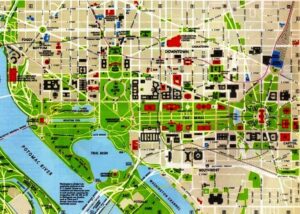 “Just throw a dart,” Sam said. Kayla had a suggestion too, “You’ve been here so many times GMom, what do you think we’d like best?” I gave a qualified answer, “I can tell you what impressed me the most, and what sticks in my mind even though I saw it years ago.” “Then let’s do THAT,” they both said, before I even told them what it was.
“Just throw a dart,” Sam said. Kayla had a suggestion too, “You’ve been here so many times GMom, what do you think we’d like best?” I gave a qualified answer, “I can tell you what impressed me the most, and what sticks in my mind even though I saw it years ago.” “Then let’s do THAT,” they both said, before I even told them what it was.
The National Archives, https://www.archives.gov/
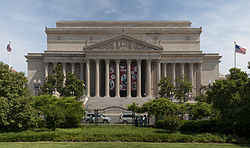 I chose the National Archives first because it is the repository of “US History” like nothing else. If you want to go straight to the horse’s mouth – it is HERE. In one room, in one building, you can see the original founding documents of the United States. The room is the Rotunda for the Charters of Freedom, and it is the permanent home of three documents that are instrumental to the founding and philosophy of the United States.
I chose the National Archives first because it is the repository of “US History” like nothing else. If you want to go straight to the horse’s mouth – it is HERE. In one room, in one building, you can see the original founding documents of the United States. The room is the Rotunda for the Charters of Freedom, and it is the permanent home of three documents that are instrumental to the founding and philosophy of the United States.
- The Declaration of Independence, written in 1776, announces a complete break with Britain and expresses the ideals on which the United States was founded: “We hold these truths to be self-evident, that all men are created equal, that they are endowed by their Creator with certain unalienable Rights, that among these are Life, Liberty and the pursuit of Happiness.”
- The Constitution is the supreme law of the United States. These four large sheets of parchment define the framework and powers of the Federal Government. Written in 1787, the Constitution established an ingenious practical system of government that derives its power from “We the People of the United States” and promotes the welfare of all its citizens.
- The Bill of Rights protects freedom of speech, press, religion, and assembly, among many other rights. The document on permanent display in the Rotunda is the enrolled original Joint Resolution passed by Congress in 1789, proposing 12 amendments to the Constitution. The 10 that were ratified became known as the Bill of Rights.
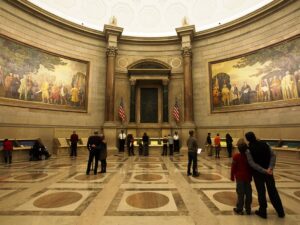 The documents are sealed in the most scientifically advanced housing that preservation technology can provide; the windowless Rotunda is carefully cooled; no sunshine and no photography allowed. Elsewhere in the building are many other important American historical items, including the Articles of Confederation, the Louisiana Purchase Treaty, the Emancipation Proclamation, and collections of photography and other historically and culturally significant American artifacts. Seeing all those original signatures excited us the most.
The documents are sealed in the most scientifically advanced housing that preservation technology can provide; the windowless Rotunda is carefully cooled; no sunshine and no photography allowed. Elsewhere in the building are many other important American historical items, including the Articles of Confederation, the Louisiana Purchase Treaty, the Emancipation Proclamation, and collections of photography and other historically and culturally significant American artifacts. Seeing all those original signatures excited us the most.
The National Gallery of Art, https://www.nga.gov/
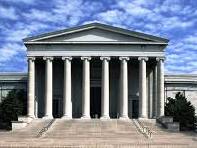 The National Gallery of Art is just across the street from the Archives, and houses more than 150,000 paintings, sculpture, decorative arts, photographs, prints, and drawings spanning the history of Western art. It was my second choice for two reasons – when Sam and Kayla were small, we visited many art museums in Seattle and they always left “sparkly-eyed” and smiling. They talked about what they had seen, and usually got the crayons out as soon as they got home. The second reason for my choice was selfish; I wanted to be there again. I remember clearly my stop in front of a particularly magnificent Rembrandt in 1998, it left me breathless. The reds were so vivid; the depth of the painting so astonishing, I just kept looking. I knew, without question, that we’d be happier after visiting there today. Plus it is so well organized, the displays can be enjoyed without jostling. And we needed that.
The National Gallery of Art is just across the street from the Archives, and houses more than 150,000 paintings, sculpture, decorative arts, photographs, prints, and drawings spanning the history of Western art. It was my second choice for two reasons – when Sam and Kayla were small, we visited many art museums in Seattle and they always left “sparkly-eyed” and smiling. They talked about what they had seen, and usually got the crayons out as soon as they got home. The second reason for my choice was selfish; I wanted to be there again. I remember clearly my stop in front of a particularly magnificent Rembrandt in 1998, it left me breathless. The reds were so vivid; the depth of the painting so astonishing, I just kept looking. I knew, without question, that we’d be happier after visiting there today. Plus it is so well organized, the displays can be enjoyed without jostling. And we needed that.
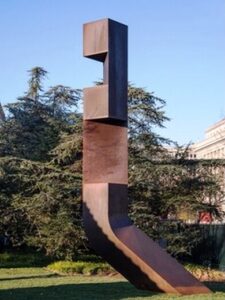 The Gallery’s Sculpture Garden was really fun, odd and wonderful sights, Kayla kept snapping photos, and Sam, who has learned welding, was fascinated by all the metal pieces, such as Halegua’s, America, 1970, a 25-ft steel construction. https://www.nga.gov/collection/sculpture-garden.html I didn’t think I’d get them to leave, but they finally got hungry. Lunch at the Pavilion Café, overlooking the gardens and grounds; in the winter, there’s an ice rink!
The Gallery’s Sculpture Garden was really fun, odd and wonderful sights, Kayla kept snapping photos, and Sam, who has learned welding, was fascinated by all the metal pieces, such as Halegua’s, America, 1970, a 25-ft steel construction. https://www.nga.gov/collection/sculpture-garden.html I didn’t think I’d get them to leave, but they finally got hungry. Lunch at the Pavilion Café, overlooking the gardens and grounds; in the winter, there’s an ice rink!
We hopped on the free shuttle and rode the few blocks to the Washington Monument. I wanted pictures of them standing beneath, with the White House in view across the Ellipse. I have a picture of their Dads standing there together, all jacketed up; it was the Christmas holidays and there were reindeer on the Mall, and a Christmas tree from every state. Not a single barricade, as there are today.
Bureau of Engraving and Printing https://www.moneyfactory.gov/home.html
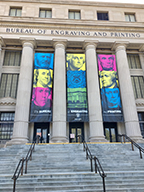 I kept my third choice a surprise; they didn’t know where we were headed until I told our taxi driver. I chose the “Money Factory” for two reasons also. On a summer visit to DC when their Dads were very young, we toured this money-making facility and they still talk about it today. I thought Sam and Kayla would be equally fascinated – the process is actually quite interesting, and involved. PLUS, most young-people-just-entering-the-workforce are obsessed with money; how to get it, spend it, and keep it.
I kept my third choice a surprise; they didn’t know where we were headed until I told our taxi driver. I chose the “Money Factory” for two reasons also. On a summer visit to DC when their Dads were very young, we toured this money-making facility and they still talk about it today. I thought Sam and Kayla would be equally fascinated – the process is actually quite interesting, and involved. PLUS, most young-people-just-entering-the-workforce are obsessed with money; how to get it, spend it, and keep it.
“Have you ever paid attention to what a dollar bill LOOKS like?” I asked. “It’s a pretty intricate design.” They looked at me. Hmmm. Well now they know. We got to see millions of dollars being printed; the tour overlooks the production floor. And they learned these facts about a dollar bill:
- The first $1 notes called “Legal Tenders” were issued by the federal government in 1862 and featured a portrait of Secretary of the Treasury Salmon P. Chase (1861-1864).
- The first use of George Washington’s portrait on the $1 note was on Series 1869 United States Notes.
- The first $1 Federal Reserve notes were issued in 1963. The design, featuring George Washington on the face and the Great Seal on the back, has not changed.
 Because the $1 note is infrequently counterfeited, the government has no plans to redesign this note. In addition, there is a recurring provision in Section 116 of the annual Financial Services and General Government Appropriations Act that prohibits the redesign of the $1 note.
Because the $1 note is infrequently counterfeited, the government has no plans to redesign this note. In addition, there is a recurring provision in Section 116 of the annual Financial Services and General Government Appropriations Act that prohibits the redesign of the $1 note.- Of all the notes printed by the Bureau of Engraving and Printing, the $1 note makes up about 45% of currency production.
- The Fiscal Year 2018 Yearly Currency Order contains 2.2 billion $1 notes.
- If you had 10 billion $1 notes and spent one every second of every day, it would require 317 years for you to go broke.
Imagine that! Last choice of the day I also kept as a surprise. We picked up some items from the Market in our hotel and grabbed a bite to eat in our room before One Last Thing. I wanted them to see the monuments after dark.
The Monuments At Night From a Red Roadster
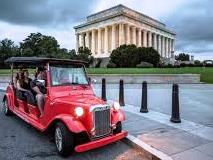 This was just about the cutest thing ever, a small 5-passenger electric RED ROADSTER, driving us all around the city after dark. The route covered everything we still wanted to see (and some we’ve seen twice); but no crowds to contend with, just us and our guide.
This was just about the cutest thing ever, a small 5-passenger electric RED ROADSTER, driving us all around the city after dark. The route covered everything we still wanted to see (and some we’ve seen twice); but no crowds to contend with, just us and our guide.
First a drive through the entire Smithsonian complex, getting the story of each of the museums; then past the Washington Monument and the Jefferson Memorial. We stopped at the FDR and MLK Memorials, and got a chance to walk along the 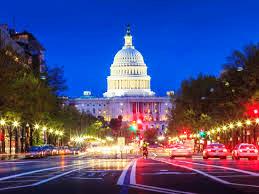 Tidal Basin. Then past the WWI and WWII Memorials to the Lincoln Memorial; great views there of the Potomac River and the National Mall, sparkling in the dark. Throughout the trip the guide gave us stories of the city’s history; then past the White House, and on to Capitol Hill, really something to see at night.
Tidal Basin. Then past the WWI and WWII Memorials to the Lincoln Memorial; great views there of the Potomac River and the National Mall, sparkling in the dark. Throughout the trip the guide gave us stories of the city’s history; then past the White House, and on to Capitol Hill, really something to see at night.
Of course, this is a fictionalized version of what we COULD have done in a COVID-free world; in reality, DC is mostly closed, or masked with limited opportunities. But this is my NDI RTW; imagining makes anything possible. Then let’s do that.
